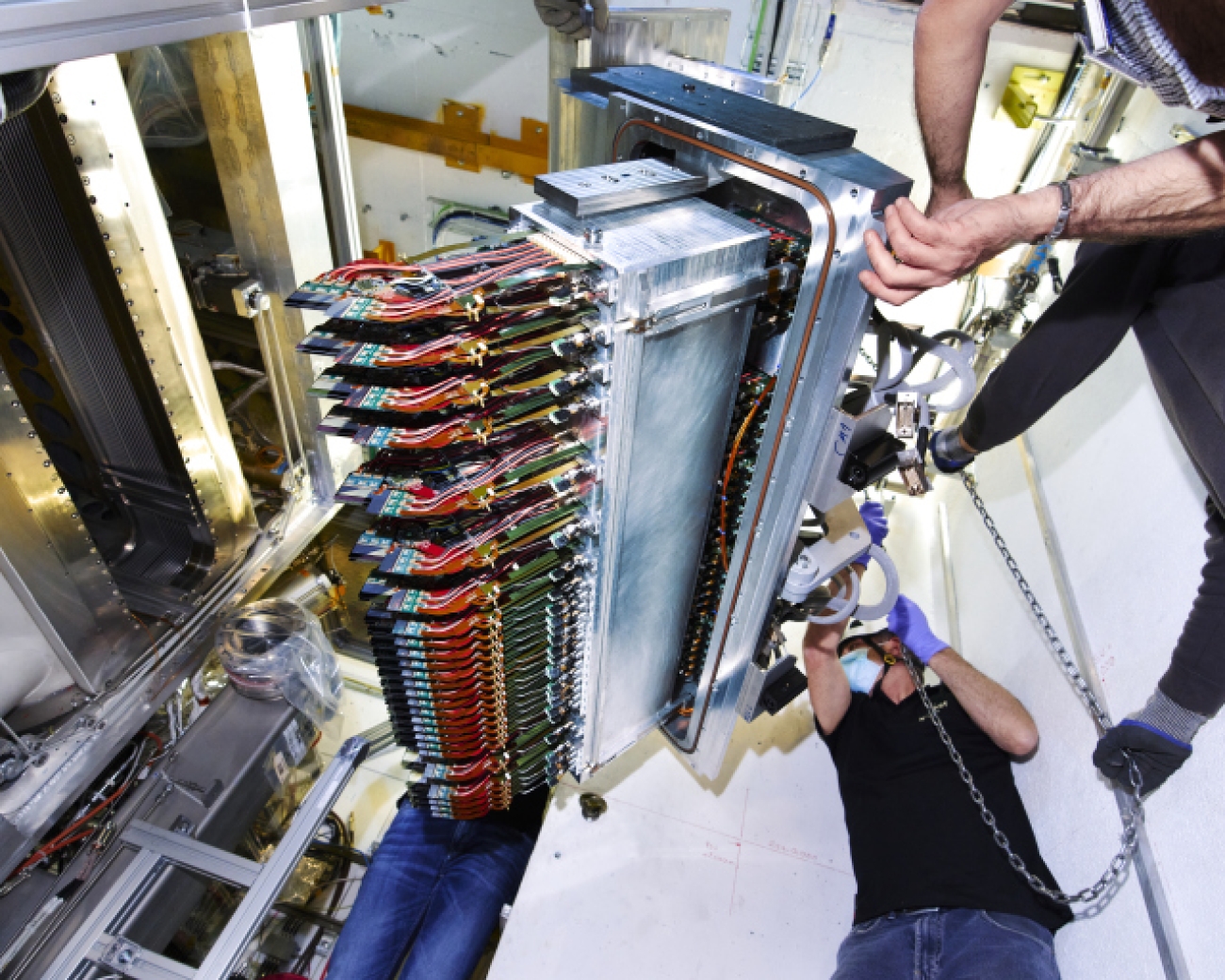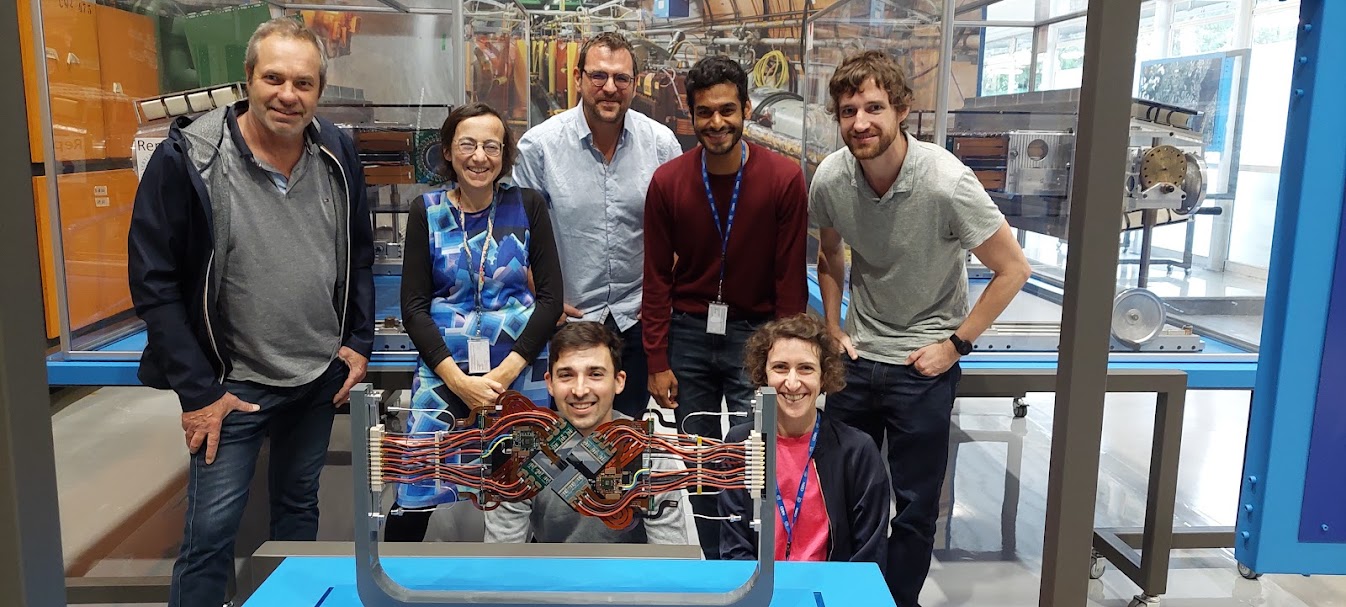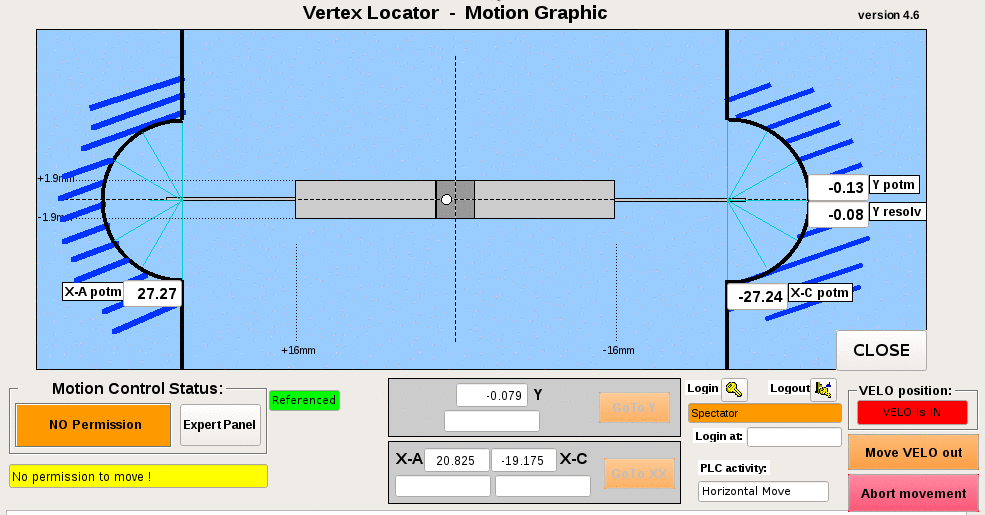LHCb VELO closes fully for the first time

At the end of October, the two halves of the new Vertex Locator (VELO) approached the LHC proton-proton collision point in a process referred to as VELO closing - following the installation of the upgraded detector. Replacing the previous VErtex LOcator (VELO) detector has been one of the key milestones for the LHCb collaboration, as part of an upgrade programme that will allow the LHC detector to cope with instantaneous luminosities of L = 2 × 1033 cm−2s−1 during Run 3.

Figure 1: Schematic of the two VELO halves, as seen from above. The two rows consist of 21 modules, where each module is made up of two silicon sensors mounted back-to-back. The VETO or pile-up stations are seen on the left. As a detector safety consideration, the VELO halves are retracted during beam injection and adjust, but closed around stable beams. The right handed co-ordinate system is shown.
The VELO detector provides key information for the event reconstruction by measuring the distance between the collision point and the point where B hadrons transform into other particles. In total, the upgraded VELO consists of 52 modules positioned in vacuum along the LHC beam-pipe, surrounding the interaction point. Compared to its predecessor, the main advantages are better resolution together with trigger-less readout at the maximal rate of 40 MHz. The silicon pixel tracking layers of the new VELO will offer improved hit resolution and simpler track reconstruction. Moreover, the VELO is located closer to the beam axis at a record distance of 5.1 mm as opposed to the previous 8.4 mm. For the best tracking performance the smallest possible amount of material has to be used in constructing all components. This choice also results in lowering the radiation damage of the sensitive parts. Finally, the new VELOPIX chip is capable of collecting signal hits from 256×256 pixels, sending data at a staggering rate of up to 20 Gb/s.
The construction of the new VELO modules has been an intense collaborative effort including the Universities of Bristol, Glasgow, Liverpool, Oxford and Warwick, Moscow State University, University of Manchester, Universidade de Santiago de Compostela, Instituto Galego de Física de Altas Enerxías, AGH University (Poland), Nikhef, UFRJ (Brazil) and CERN. Module construction started in November 2021 at the University of Manchester (UK) and NIKHEF (NL). The VELO modules were shipped to the University of Liverpool where they were assembled into their mechanical support and cooling structures, forming the two detector halves. Following functionality and safety testing the two halves were shipped to CERN, earlier this year, for installation in the LHCb cavern.
The new VELO was installed at the LHCb experiment last May, just in time for the start of the third LHC run. This step marked the end of a 15 year journey of development and construction. Installing a new detector is a delicate process requiring detailed preparation and smooth coordination. Detailed drawings of the detector base, cooling capillaries, cable and modules served to guide the installation. Furthermore, the real-life placement of the sensors and RF-foil undergoes a very precise metrology, ensuring that the different parts agree within the tolerance of a few hundreds of micrometers.
The two halves of the VELO detector are located some centimeters from the expected proton-proton collision point while protons are injected in the LHC. LHC operators perform a number of steps from the CCC, adjusting the two beams, before the state of perfect and safe conditions of proton-proton collisions named “Stable Beams” is achieved. The LHCb team has to wait for this moment, before moving the two VELO halves close to the collision point. The flags indicating "stable beams" and "moveable devices allowed in" must be positive in the control room, indicating that the CCC has finished adjusting the circulating beams and considers them safe for the VELO to approach.
This delicate procedure, for the safe and efficient closure of the VELO during stable beams, was implemented earlier in October. Part of the complexity stems from the fact that the proton-proton collision point varies from fill to fill; thus one needs to measure the precise location of these collisions using the VELO detector. This location is measured approximately when the detector halves are located relatively far from the beam. Based on this measurement, a decision is made as to whether to move both halves a little bit closer. Through an iterative process that involves measurements of this location and careful manipulation of the subdetectors closer to the beam , the two VELO halves reach the final position about 3 mm from the interaction point. This process is named as the closing of the VELO.
The animation above shows the control screen during the automatised closing process of the previous Run 1 and 2 VELO system.
The VELO closing took place on the 21st of October for the first time in Run 3 by the VELO team crew located in front of VELO control screens in the LHCb control room. This procedure was filmed and is shown in the video.
The VELO team crew will continue to close the VELO manually for the next period. Later on the process will be automated and monitored on a special control screen by the LHCb main shift crew.

Group photo of the VELO team crew.

